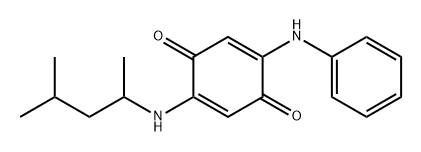6PPD-quinone
- CAS No.
- 2754428-18-5
- Chemical Name:
- 6PPD-quinone
- Synonyms
- 6PPD-Q;6PPD-quinone;Phentolamine Impurity 31;N-(1,3-dimethylbutyl)-N′-phenyl-p-phenylenediamine quinone;2-[(1,3-dimethylbutyl)amino]-5-(phenylamino)-2,5-cyclohexadiene-1,4-dione;2,5-Cyclohexadiene-1,4-dione, 2-[(1,3-dimethylbutyl)amino]-5-(phenylamino)-;2-((4-methylpentan-2-yl)amino)-5-(phenylamino)cyclohexa-2,5-diene-1,4-dione;2- ((4-methylpent-2-yl) amino) -5- (phenylamino) cyclohex-2,5-diene-1,4-dione;(R)-2-((4-methylpentan-2-yl)amino)-5-(phenylamino)cyclohexa-2,5-diene-1,4-dione;(S)-3,6-dimethylene-N1-(4-methylpentan-2-yl)-N4-phenylcyclohexa-1,4-diene-1,4- diamine
- CBNumber:
- CB810899610
- Molecular Formula:
- C18H22N2O2
- Molecular Weight:
- 298.38
- MDL Number:
- MOL File:
- 2754428-18-5.mol
| Boiling point | 442.2±45.0 °C(Predicted) |
|---|---|
| Density | 1.12±0.1 g/cm3(Predicted) |
| solubility | Acetonitrile (Slightly), Chloroform (Slightly), Ethyl Acetate (Slightly) |
| form | Solid |
| pka | 0.61±0.20(Predicted) |
| color | Dark Orange to Dark Red |
| InChI | InChI=1S/C18H22N2O2/c1-12(2)9-13(3)19-15-10-18(22)16(11-17(15)21)20-14-7-5-4-6-8-14/h4-8,10-13,19-20H,9H2,1-3H3 |
| InChIKey | UBMGKRIXKUIXFQ-UHFFFAOYSA-N |
| SMILES | C1(=O)C=C(NC2=CC=CC=C2)C(=O)C=C1NC(C)CC(C)C |
6PPD-quinone Chemical Properties,Uses,Production
Description
6PPD-quinone is an oxidized derivative of the tire antiozonant and substituted p-phenylenediamine 6-PPD. It is toxic to rainbow trout (O. mykiss) and brook trout (S. fontinalis; LC50s = 0.59 and 1.96 μg/L, respectively) but not to arctic char (S. alpinus) and white sturgeon (A. transmontanus; LC50s = >12.7 μg/L for both). 6PPD-quinone (10 μg/L) induces cell death and germline DNA damage and decreases the number of mitotic cells in C. elegans gonads. Urine levels of 6-PPD-quinone are increased in pregnant women compared to non-pregnant adults and children.
Uses
6PPD-Q (6PPD-Quinone) is an environmental pollutant that can be detected in human urine and is widely present in the environment. 6PPD-Q targets and binds to CNR2, CNR1, AA2AR, LCAT, and TRPA1, with CNR2 exhibiting the highest binding affinity, potentially acting as a CNR2 receptor agonist to activate cannabinoid receptors. 6PPD-Q induces intestinal inflammation and barrier damage by disrupting mitochondrial function, reducing neuronal glycolysis metabolites and TCA cycle intermediates, and exacerbating α-synuclein (α-syn) aggregation. 6PPD-Q is applicable in research on environmental toxicology, neurodegenerative diseases, and inflammation-related disorders[1].
Biochem/physiol Actions
Studies have shown that 6PPD/6PPD-quinone can interact with human serum albumin (HSA). It spontaneously inserts into the I-site of HSA, forming a binary complex that induces changes in the secondary structure of HSA. However, their effects on the esterase-like activity of HSA are polarised. 6PPD activates the esterase-like activity of HSA, whereas 6PPD-quinone inhibits it. Molecular docking analyses showed that 6PPD and 6PPD-quinone interact with many amino acid residues on HSA, including TRP214, ARG222, ARG218, ALA291, and PHE211. π-electrons on the benzene ring of 6PPD/6PPD-quinone play a key role in maintaining the stability of the complex. In addition, the stronger binding affinity between 6PPD and HSA compared to 6PPD-quinone could be attributed to the greater negative surface potential of 6PPD.
Safety
6PPD-quinone (6PPD-q) is an oxidation product of the antioxidant N-(1,3-dimethylbutyl)-N′-phenyl-p-phenylenediamine (6PPD) present in rubber. Studies have shown that 6PPD and 6PPD- q are also present in human urine, including adults, children, and pregnant women, and that urinary 6PPD- q concentrations were significantly higher than 6PPD; pregnant women had significantly higher concentrations of 6PPD and 6PPD- q (median 0.068 and 2.91 ng/mL, respectively) than adults (0.018 and 0.40 ng/mL) and children (0.015 and 0.076 ng/mL). The high daily urinary excretion of 6PPD-Q in pregnant women was estimated to be 273 (ng/kg bw)/day. 6PPD-Q is a lethal toxicant to a wide range of aquatic species, and its potential risk to human health from long-term exposure requires urgent attention.
in vivo
6PPD-Q (0.1, 1, 10, 100 μg/kg, p.o., once daily for 21 days) induces intestinal injury in ICR mice, characterized by increased inflammatory response in the jejunum and ileum and impaired intestinal barrier integrity[3].
| Animal Model: | 6PPD-Q-induced intestinal injury ICR mouse model[3] |
| Dosage: | 0.1, 1, 10, 100 μg/kg |
| Administration: | Oral gavage (p.o.), once daily for 21 days |
| Result: | Dose-dependently disrupted intestinal barrier integrity, primarily affecting the jejunum and ileum, with no significant impact on the duodenum and colon. At exposure doses ≥10 μg/kg, TNF-α, IL-1, and IL-6 levels significantly increased, indicating intestinal inflammation. |
IC 50
α-synuclein Aggregation
References
[1] Du B, et al. First report on the occurrence of N-(1, 3-dimethylbutyl)-N’-phenyl-p-phenylenediamine (6PPD) and 6PPD-quinone as pervasive pollutants in human urine from south China. Environ Sci Technol Lett, 2022, 9(12): 1056-1062.
[2] Fang J, et al. 6PPD-quinone exposure induces neuronal mitochondrial dysfunction to exacerbate Lewy neurites formation induced by α-synuclein preformed fibrils seeding. J Hazard Mater. 2024 Mar 5;465:133312. DOI:10.1016/j.jhazmat.2023.133312
[3] Yang Y, et al. Environmentally realistic dose of tire-derived metabolite 6PPD-Q exposure causes intestinal jejunum and ileum damage in mice via cannabinoid receptor-activated inflammation[J]. Science of The Total Environment, 2024, 918: 170679. DOI:10.1016/j.scitotenv.2024.170679
6PPD-quinone Preparation Products And Raw materials
Raw materials
Preparation Products
6PPD-quinone Suppliers
| Supplier | Tel | Country | ProdList | Advantage | |
|---|---|---|---|---|---|
| Wuhan Jingkang en Biomedical Technology Co., Ltd | +8613720134139 | orders@jknbiochem.com | China | 5221 | 58 |
| TargetMol Chemicals Inc. | +17819995354 | marketing@targetmol.com | United States | 32302 | 58 |
| Henan Alfa Chemical Co., Ltd | +8615838112936 | alfa10@alfachem.cn | China | 13016 | 58 |
| Zhengzhou Anhuida Chemical Co., Ltd | +8615903659408 | admin@ahdchem.com | China | 286 | 58 |
| LEAPCHEM CO., LTD. | +86-852-30606658 | market18@leapchem.com | China | 43340 | 58 |
| Jilin Chinese Academy of Sciences-yanshen Technology | +undefined18143011203 | info@chemextension.com | China | 42056 | 58 |
| Zhengzhou Huiju Chemical Co., Ltd. | 0371-55900031 18137872243 | 2853979815@qq.com | China | 9990 | 55 |
| Wuhan Jingkangen Biomedical Technology Co., Ltd | 13720134139 086-15871494362 13720134139 | orders@jknbiochem.com | China | 6198 | 58 |
| Hefei Chengquan Biotechnology Co., Ltd | 0551-0551130 13034045150 | 402974597@qq.com | China | 193 | 58 |
| Beijing HwrkChemical Technology Co., Ltd | 18515581800 18501085097 | sales.bj@hwrkchemical.com | China | 9373 | 55 |






